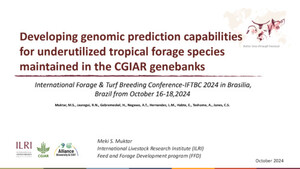
Conservation agriculture in mixed crop-livestock systems: Scoping crop residue trade-offs in Sub-Saharan Africa and South Asia
Abstract
Conservation Agriculture (CA) is being advocated to enhance soil health and sustain long term crop productivity in the developing world. One of CA's key principles is the maintenance of soil cover often by retaining a proportion of crop residues on the field as mulch. Yet smallholder crop–livestock systems across Africa and Asia face trade-offs among various options for crop residue use. Knowledge of the potential trade-offs of leaving more residues as mulch is only partial and the objective of this research is to address some of these knowledge gaps by assessing the trade-offs in contrasting settings with mixed crop–livestock systems. The paper draws from village surveys in 12 sites in 9 different countries across Sub-Sahara Africa and South Asia. Sites were clustered into 3 groups along the combined population and livestock density gradients to assess current crop residue management practices and explore potential challenges to adopting mulching practices in different circumstances. Results show that although high-density sites face higher potential pressure on resources on an area basis, biomass production tends to be more substantial in these sites covering demands for livestock feed and allowing part of the residues to be used as mulch. In medium-density sites, although population and livestock densities are relatively lower, biomass is scarce and pressure on land and feed are high, increasing the pressure on crop residues and their opportunity cost as mulch. In low-density areas, population and livestock densities are relatively low and communal feed and fuel resources exist, resulting in lower potential pressure on residues on an area basis. Yet, biomass production is low and farmers largely rely on crop residues to feed livestock during the long dry season, implying substantial opportunity costs to their use as mulch. Despite its potential benefit for smallholder farmers across the density gradient, the introduction of CA-based mulching practices appears potentially easier in sites where biomass production is high enough to fulfil existing demands for feed and fuel. In sites with relatively high feed and fuel pressure, the eventual introduction of CA needs complementary research and development efforts to increase biomass production and/or develop alternative sources to alleviate the opportunity costs of leaving some crop residues as mulch.
Citation
Valbuena, D., Erenstein, O., Homann, S., Abdoulaye, T., Claessens, L., Duncan, A.J., Gérard, B., Rufino, M.C., Teufel, N., Rooyen, A. van and Wijk, M.T. van. 2012. Conservation agriculture in mixed crop-livestock systems: Scoping crop residue trade-offs in sub-Saharan Africa and South Asia. Field Crops Research 132:175-184.









